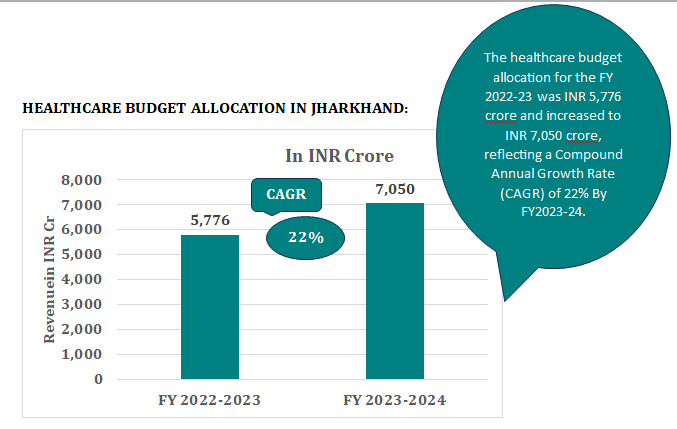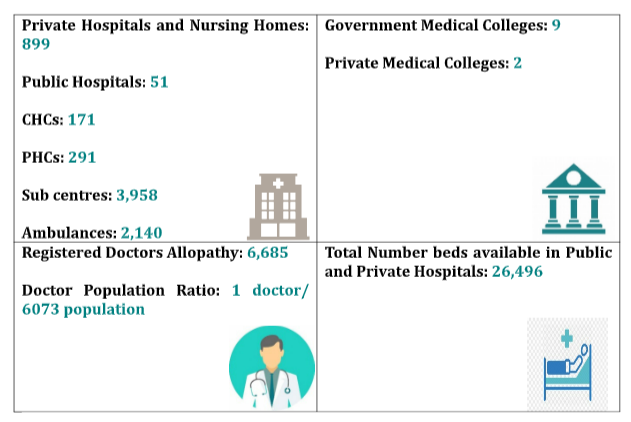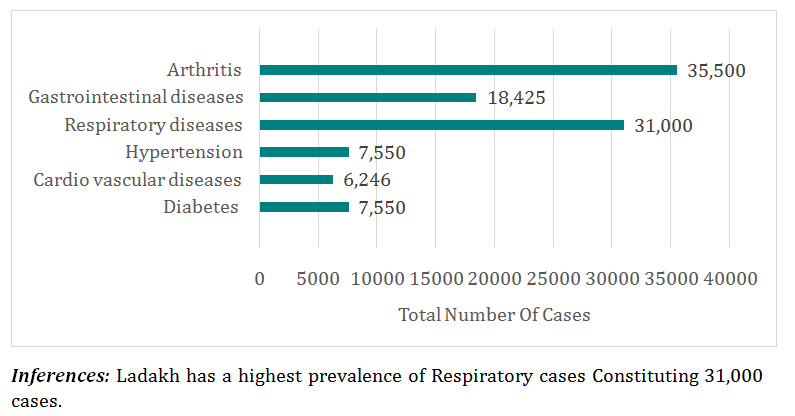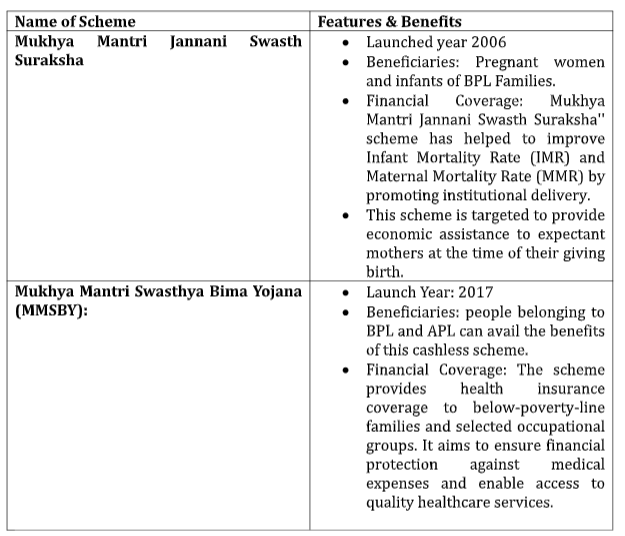Are you currently looking into venturing or investing into the healthcare sector in
Jharkhand? Are you looking for concrete details on the current status of the Healthcare
scenario in Jharkhand? In this article, Hospaccx Healthcare Consultancy brings to you
the latest bits of Information on Jharkhand current Healthcare Systems.
INTRODUCTION: Jharkhand, located in eastern India, is a state that grapples with
several healthcare challenges but also exhibits potential for growth and development in
its healthcare sector. The state faces issues such as inadequate healthcare
infrastructure, shortage of healthcare professionals, and limited access to medical
facilities in remote areas. However, Jharkhand has taken significant steps to address
these issues and improve healthcare services. Emphasizing preventive care, health
education, and awareness programs can play a crucial role in reducing the burden of
diseases, ultimately enhancing the overall well-being of the people of Jharkhand. In this
blog, we aim to provide you with insights into the current state of healthcare in
Jharkhand, shedding light on the government initiatives, disease burden and healthcare
infrastructure that shape the healthcare industry landscape.



HEALTH INDICATORS

DISEASE BURDEN IN LADAKH:

DISEASE BURDEN IN JHARKHAND:

HEALTHCARE INITIATIVES BY JHARKHAND GOVERNMENT

MAJOR LIST OF GOVERNMENT HOSPITALS
- Rajendra Institute of Medical Sciences (RIMS), Ranchi: Established in 1960, is located on Bariatu Road and has a bed capacity of over 1,500, institute is spread over 214 acres serving as a premier medical institute for comprehensive healthcare services, medical education, and research facilities.
- Mahatma Gandhi Memorial Medical College and Hospital, Jamshedpur: founded in 1961 and situated on Dimna Road, Mango, offers comprehensive healthcare services to the community with a bed capacity of over 540, campus is spread over 45 acres.
- Patliputra Medical College and Hospital, Dhanbad: Established in 1971 and located in Bank More, provides a wide range of healthcare services with a bed capacity of over 500, institute is spread over 60 acres.
- Hazaribagh Medical College and Hospital, Hazaribagh: was established in 2019 to offer medical education and healthcare services to the community with a bed capacity of over 500, the campus is spread over 25 acres.
- Dumka Medical College and Hospital, Dumka: Established in 2019, aims to cater to the healthcare needs of the local population and neighbouring regions with a bed capacity of over 500. The institute is spread over 25 acres.
- Palamu Medical College and Hospital, Palamu: Established in 2019, with the goal of providing comprehensive medical education and healthcare services to the community with a bed capacity of over 330. The campus is spread over 12 acres.
- Sadar Hospital was laid in 2007, a 4.5 crore government healthcare facility with over 100 beds that is spread out over 3 acres in Khasmahal.
MAJOR LIST OF PRIVATE HOSPITALS
- Tata Main Hospital, Jamshedpur: Established in 1908, Tata Main Hospital in Jamshedpur has 983 beds and is associated with the Tata Steel group. It is known for its advanced healthcare facilities and specialized treatments. The hospital is spread over 70,000 sq. meters.
- Narayani Super Speciality Hospital, Jamshedpur: Narayani Super Speciality Hospital, established in 2008, is a leading private hospital in Jamshedpur. It has a bed capacity of 150 and 5 operation theatres, and provides advanced medical care across various specialties.
- Orchid Medical Centre, Ranchi: Established in 2009, Orchid Medical Centre is a well-known private hospital in Ranchi. The hospital has a bed capacity of 135 beds.
- Devkamal Hospital, Hazaribagh: Devkamal Hospital, a trusted name in Hazaribagh, established in 2008. has been serving the community for more than two decades. The hospital has a bed capacity of over 100 beds and 10 ICU beds.
LIST OF MAJOR MEDICAL COLLEGES
- Rajendra Institute of Medical Sciences (RIMS), Ranchi: Established in 1960, is located on Bariatu Road and has a bed capacity of over 1,500, institute is spread over 214 acres and Which has an intake of MD/MS seats 24, and 180 MBBS seats. Serving as a premier medical institute for comprehensive healthcare services, medical education, and research facilities.
- Mahatma Gandhi Memorial Medical College and Hospital, Jamshedpur: Founded in 1961 and situated on Dimna Road, Mango, offers comprehensive healthcare services to the community with a bed capacity of over 540, campus is spread over 45 aces. The institute has an intake of 100 MBBS seats. emphasizing medical education and research initiatives.
- Patliputra Medical College and Hospital, Dhanbad: Established in 1971 and located in Bank More, provides a wide range of healthcare services with a bed capacity of over 500, institute is spread over 60 acres. It has an intake of 50 MBBS seats. While also focusing on medical education and research opportunities.
- Hazaribagh Medical College and Hospital, Hazaribagh Established in 2019 to offer medical education and healthcare services. The number of beds is 500. The campus is spread over 25 acres. It has an intake of 100 MBBS seats.
- Dumka Medical College and Hospital, Dumka Established in 2019, aims to cater to the healthcare needs of the local population and neighbouring regions. number of beds are 500. The institute is spread over 25 acres. Institute has an intake of 100 MBBS seats.
- Palamu Medical College and Hospital, Palamu, Established in 2019, with the goal of providing comprehensive medical education and healthcare services with the total number of beds are 330. Which is spread over 12 acres. This institute has an intake of 100 MBBS seats.
HEALTHCARE INVESTMENT OPPORTUNITIES IN JHARKHAND:
- Growing population:
- The population of Jharkhand for the year 2023 is 4.06 Crores and is estimated to project 4.71 Crores by the year 2030 with annual growth rate of 2.14%
- Gap in medical infrastructure:
- In the state, the total number of available beds, including both government and private sectors, is 26,496 beds. According to the norms, there should be 5 beds per 1,000 population. Hence, there is a need for 2,00,000 beds, indicating a gap of 1,73,504 beds in the state’s healthcare infrastructure.
- Currently there are 227 diagnostic centres in Jharkhand. As per the norms there should be 1 diagnostic centre per 10,000 population. Therefore, there is a requirement of 4,000 diagnostic centre indicating a gap of 3,773 diagnostic centre in the state.
- Government assistance in healthcare investment:
a)Creating a Medical College in the Private Sector and Offering Incentives:
- 20 crores (in 2 equal Instalments) for 50 seats
- 25 crores (in 3 equal instalments) for 100 seats
- 30 crores (in 4 equal instalments) for 150 seats
b)Comprehensive Project Investment Subsidy (CPIS):
- MSME units are eligible to receive the Comprehensive Project Investment Subsidy (CPIS) for investments made in fixed capital investments. The amount of the CPIS subsidy for MSME will be 20% of the investments made in fixed capital. 20% of Fixed Capital Investment with a maximum of Rs. 2 crores will be the maximum admissible subsidy under CPIS for MSMEs. Entrepreneurs from the SC/ST/Women/Handicapped groups will receive an extra 5% benefit under CPIS. The industries will only receive a single CPIS category subsidy.
c)Stamp duty and Registration fee:
- Industrial units will be 100% exempt from paying stamp duty and registration fees for land they directly purchase from raiyats or acquire through consent awards. Industrial parks and IADA lessees are not eligible for these benefits. Only the initial transaction for a specific land plot will be eligible for this facility.
d)Subsidy / Incentive on VAT:
- All industries, including MSME will be able to take advantage of this facility, as VAT Incentive: For five years starting from the date of production, new MSME units will receive an incentive of 80% NET VAT payable per year, up to a maximum of 100% of the total fixed capital investment made.
e)Encouragement for Cluster Development:
- The State Government shall offer to Cluster Schemes approved by the Government of India for the State to SPV/promoter a grant of 15% of the grant released by the Government of India.
f)Interest Subsidy:
- New MSME units and non-MSME sector units are eligible for interest subsidy for on-time repayment of the total loan obtained from public financial institutions / banks for a period of five years from the date of beginning of production, up to a total maximum limit of Rs. 10 lakhs for Micro Enterprises, Rs. 20 lakhs for Small Enterprises, Rs. 40 lakhs for Medium Enterprises, and Rs. 1 crore for non-MSME Sector units.
- Units that were designated as non-performing assets (NPA) at the time of application will not be qualified to receive this incentive. The guarantee fee charged to Micro and Small Enterprises under the Credit Guarantee Trust for Micro and Small Enterprises (CGTMSE) scheme is in addition to the interest subsidy.
g)Incubation Centres for Start-ups:
- Through the Single Window Clearance mechanism, the GoJ is proposing to offer financial grants for incubation centres in designated higher education institutions of up to Rs. 10 crore or 90% of the project cost, whichever is lower.
CONCLUSION
The healthcare scenario in Jharkhand in 2023 presents a mix of challenges and opportunities. The state faces significant issues such as inadequate infrastructure, shortage of healthcare professionals, and high rates of malnutrition and infectious diseases. However, there are encouraging signs of progress and initiatives by the government to address these challenges. Despite the progress, there are still investment opportunities in the healthcare sector, considering the state’s growing population and the existing gaps in medical infrastructure and diagnostic facilities. The government’s assistance through various incentives, subsidies, and encouragement for cluster development and start-ups can attract private investors and entrepreneurs to contribute to the healthcare sector’s growth. In moving forward, Jharkhand needs to continue emphasizing preventive care, health education, and awareness programs, along with leveraging technology to bridge the gap between rural communities and healthcare services. By fostering collaboration between the government, healthcare providers, and communities, Jharkhand can take significant strides towards transforming its healthcare landscape, improving health outcomes, and ensuring better well-being for its population.
Above is the superficial and macro level study for in-depth market and financial feasibility studies or any other healthcare-related research needs, please feel free to reach out to us at +91-8655170700 or email us at hospaccx.india@gmail.com. Our team is equipped to provide comprehensive and detailed insights tailored to your specific requirements.

